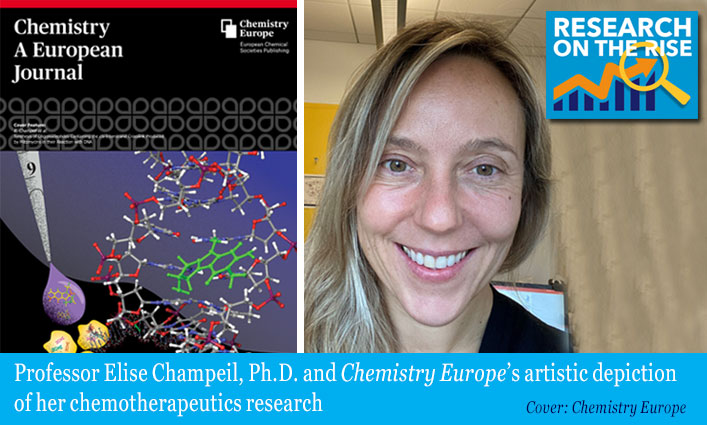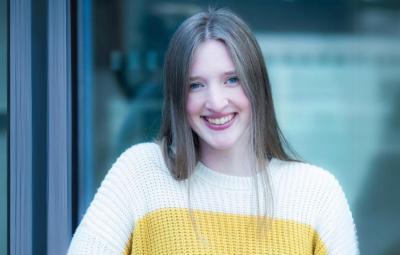
“Research sits at the core of our mission to educate for justice,” says President Karol V. Mason. The remarkable research that our esteemed faculty, students, and alumni perform directly impacts our society and helps move the needle forward toward creating a more just world. Their empirical data reveals inconsistencies, pushes boundaries, and opens minds to a whole new way of thinking. Our “Research on the Rise” series aims to showcase the ongoing, upcoming, and noteworthy research happening right here at John Jay.
Science Professor Elise Champeil, Ph.D., a bio-organic chemist, has been teaching at John Jay for over 15 years, and for much of that time, as she has guided our students through challenging organic chemistry classes, she’s also been researching ways to make chemotherapeutics more effective at killing cancer cells. Champeil has included over 35 students in hands-on research for the project, and incorporated the talents of other professors, including Shu-Yuan Cheng, Ph.D., and Lissette Delgado-Cruzata, Ph.D. “Getting the best treatment for cancer that we can is the motivator that drives all of us in this work,” says Champeil. We sat down with her to learn more about this important research happening at John Jay College.
Can you explain this very specific, scientific research to us?
Sure. We’re looking at how cancer drugs function when they go inside of the cells. The drugs actually bind onto the DNA in our chromosomes. They prevent DNA from replicating. When you have highly proliferating cells that are cancerous, they get healed by the drug because they can’t replicate. What we do in our lab is use bits of artificial DNA, called oligonucleotides. Essentially, we’ve developed a method to put the cancer drug specifically on certain types of cross-links between the two DNA strands. Then we’re investigating exactly how the structure varies and what effects it has on the cells. We’re interested in seeing if some cells die more quickly than others, depending on the cross-link. The goal is to find the most beneficial links in stopping replication.
“We’ve developed a method to put the cancer drug specifically on certain types of cross-links between the two DNA strands.” —Elise Champeil
Maybe it’s because in the cell, the enzymes recognize the crossings differently, so they send different signals to the cell’s biochemistry? There are a lot of things we don’t know and we are trying to figure out exactly what’s going on. We also hope to understand the cell’s biology and how some cancer cells are more lethal than others. We want to design more efficient chemotherapeutics. Right now, we’re specifically looking at a drug that we’ve found to be more efficient at killing cancer cells, but also less toxic to other cells. We want to know why this is happening and track its progress compared to previous kinds of chemotherapeutics.
If this John Jay project is successful, would we want to create a new drug, or would we want to use this information and disseminate it to drug companies to make their drugs more effective?
It can be both. Making a new drug, like the candidate we’re interested in now, would imply a whole other level of research. To really develop the drug, you have to try it on animals and conduct many studies, and we are not equipped to do that here. Potentially, it can then be done in other labs with some other type of funding, but we wouldn’t be able to bring the drug all the way to development. But, we are providing information on the biology and the mechanisms of how those drugs work, and why some are more efficient than others.
What type of research are the students involved in on the project?
They are really hands-on with this research. The students are the ones actually doing the experiments—using the drugs, working with the DNA bits that we have, transfecting the cells, and looking at how the cells respond. I’ve had over 35 students working on this project since I came to John Jay 15 years ago. We’ve had students who worked on this project that have entered different medical schools and Ph.D. programs. All of them are highly motivated, excited about the work, and dedicated to this research.
“The students are the ones actually doing the experiments—using the drugs, working with the DNA bits that we have, transfecting the cells, and looking at how the cells respond.” —Elise Champeil
We’re also very fortunate to have a lot of collaboration from other faculty members. Dr. Cheng is the one who works with the cells. We give her our compounds, our big DNA molecules modified, and then she transfects the cells and analyzes the cells’ response. Dr. Delgado works with RNA expressions, looking at how the different genes are triggered by the presence of the drug in the cells.
How is this research important in terms of justice issues and concerns?
To me, justice would mean eradicating these deadly diseases. Many of them predominantly affect poor people, or people who don’t have the luxury of having a healthy lifestyle, or sometimes there are ethnic disparities in the way some cancers impact a specific group of people. If we can eradicate that, it’s bringing the most precious thing to everyone in every community—the ability to be healthy. To me, that is important.
Listen to Science Professor Elise Champeil, Ph.D. sing the praises of her John Jay student researchers.



